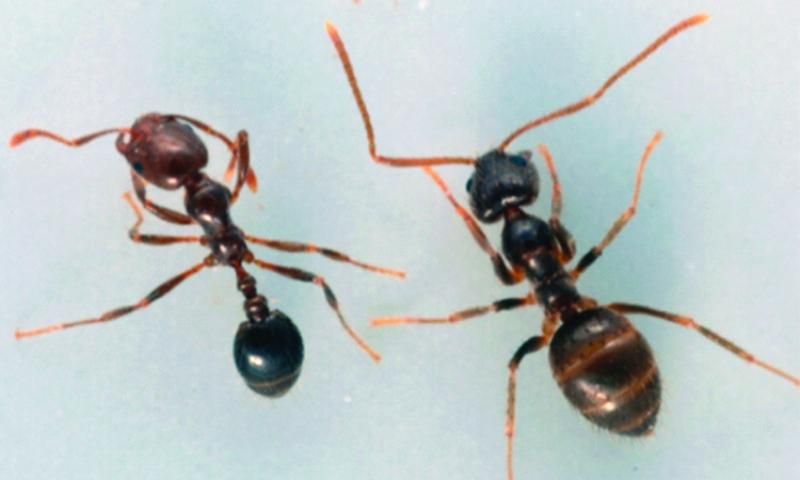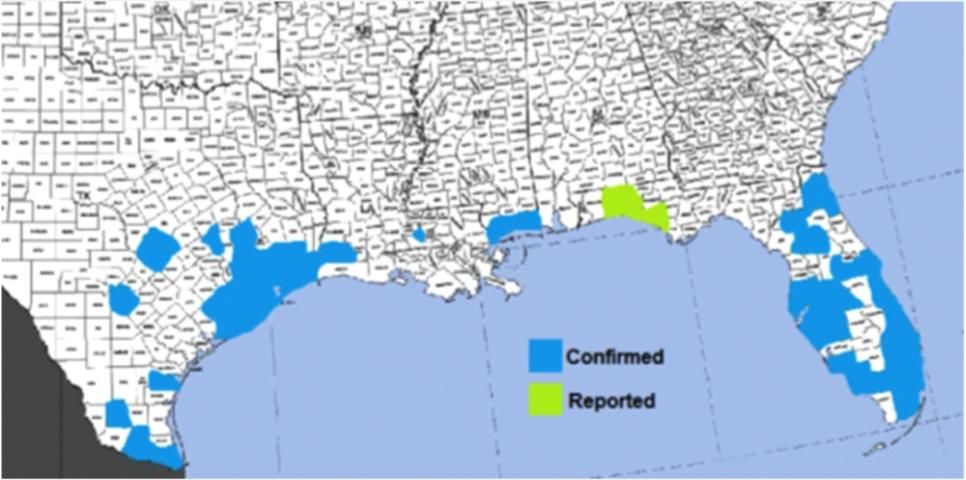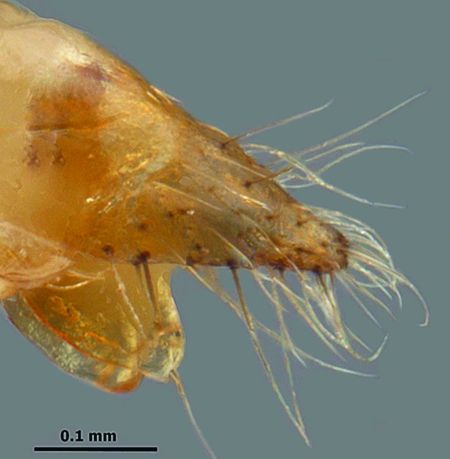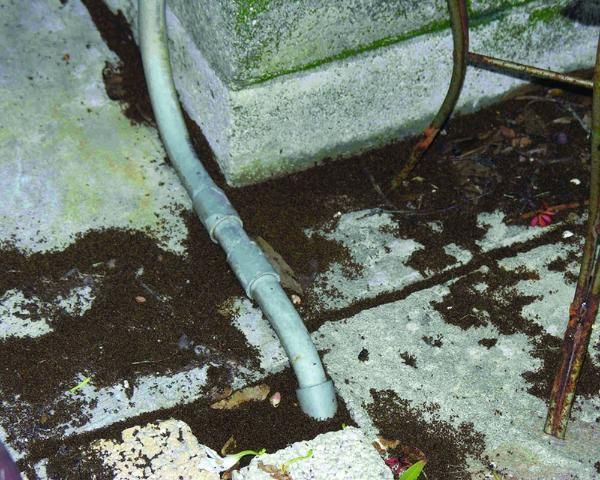
Credits: UF/IFAS
Introduction
Large populations of a new species of crazy ant were found in Florida in the 1990s. These early infestations were identified as Paratrechina pubens (Forel), or Caribbean crazy ant, because of reports of Caribbean crazy ants in South Florida in the 1950s. The new species rapidly spread over most of Florida and several other Gulf Coast states. Large populations of these ants discovered in Texas in 2002 were classified as "Paratrechina species near pubens" because of minor morphological variations from P. pubens. However, through the use of genetic and morphological studies, it is now known that the pest ant that invaded the Gulf Coast states is really a species from central Brazil. It is known currently by the specific name Nylanderia fulva, or tawny crazy ant (Figure 1).

Distribution
Caribbean crazy ant, Paratrechina pubens (Forel) is an ant that occurs in St. Vincent, Lesser Antilles, and West Indian islands including Anguilla, Guadeloupe, and Puerto Rico. Tawny crazy ant, Nylanderia fulva, is a separate species that has a different distribution and point of origin.
The tawny crazy ant originates from Brazil and was introduced into Colombia as a biological control agent against leaf-cutting ants (Atta sp.) and poisonous snakes during the 1930s and 1940s. Nylanderia pubens has been documented from Anguilla, Argentina, Bermuda, Brazil, Colombia, Cuba, Guadeloupe, Martinique, Mexico, Panama, Puerto Rico, Lesser Antilles, and the U.S. Virgin Islands.
In 2002, a significant infestation of tawny crazy ants was found in Texas and was referred to as the "Rasberry crazy ant." By 2012, N. fulva was found in 24 counties in Florida: Alachua, Brevard, Broward, Clay, Collier, DeSoto, Duval, Hardee, Hillsborough, Indian River, Lee, Manatee, Marion, Martin, Miami-Dade, Orange, Palm Beach, Pasco, Pinellas, Polk, Saint Johns, Saint Lucie, and Sarasota. Infestations were expanding (Figure 2). This can be expected in any county in Florida.

Description
Tawny crazy ant is a one-node, reddish brown ant with monomorphic workers 2.0–2.4 mm long. The males and queens are slightly larger, measuring 2.4–2.7 mm to 4.0 mm or more, respectively. The ant body is covered with hairs, but the head is hairless, darker and shiny. Tawny crazy ants have a 12-segmented antenna with no club, and a long scape about two times the width of the head. The thorax and abdomen are smooth and shiny except for areas with a dense yellow growth of hairs. The gaster, after feeding, is lighter in color and appears striped because it is stretched. Worker ants cannot be distinguished from ants of Nylanderia pubens, so clear identification of the species requires observation of males. In tawny crazy ant males, the paramere is lightly sclerotized and has few macrosetae originating from its margin (Figure 3), as opposed to the heavily sclerotized paramere in N. pubens.

Colonies
Tawny crazy ant is polygyne, with several queens in a colony, and polydomous, with the colony occupying several nests. It can form super colonies. New nests are formed by budding when one or more queens leave the original nest and form a separate nest. Super colonies form very large communities where workers mix freely across the community, lack aggression behaviors toward nestmates, and share resources. These characteristics allow the colony to expand without any limits, so super colonies extend over a large area.
Depending on the abiotic conditions, tawny crazy ants construct one of two types of nests: permanent or temporary. Permanent nests are always occupied and are found in protected areas such as in rich leaf litter under trees. Temporary nests are formed when conditions are favorable for population growth. Temporary nests are found under leaf debris, waste material, in soil crevices, and other protected habitats. The temporary nests are thought to be used as tawny crazy ants invade new areas.
Feeding Habits
Tawny crazy ants are opportunistic generalists that tend aphids and consume the honeydew secretions, prey on live animals, and scavenge from dead animals. These ants have been observed tending aphids and scale insects to collect honeydew, moving these insects from infested plants to uninfested plants. This association between the ants and sap-sucking insects damages the plant health directly, through loss of nutrients, or indirectly, through transmission of plant diseases they may vector.
Tawny crazy ants feed on small arthropods such as caterpillars, beetle, termites, wasps, and spiders, or even small animals such as rabbits, birds, lizards, and domestic animals, which usually die due to asphyxia. Given a choice, tawny crazy ants consume more food with a 1:2 protein-to-carbohydrate ratio, but they regulate the amount of each nutrient to meet colony needs.
Pest Status and Control
The tawny crazy ant is considered a serious pest in its native and introduced regions. It is considered a tramp species that infests buildings and greenhouses. It can attack several crop plants, domestic animals, and honeybee hives, and it displaces native ant species. The tawny crazy ant, like many other ants, is attracted to electricity, infesting electrical switch boxes, causing shortages, and causing equipment failures.
Tawny crazy ants are an areawide problem, not an individual-lot problem. The reduction of a tawny crazy ant population on one lot does not guarantee that the ants will not reinvade from adjacent areas. Tawny crazy ants affect entire communities, and can be controlled better if tackled as a community problem with simultaneous control measures over large areas.
Broad-spectrum baits and residual insecticides applied outside of structures deter the ants, but control is usually only for a short time before the ant population resurges. Control of N. fulva is difficult due to their high numbers, weak foraging on most traditional ant baits, and low efficacy of many pesticides against this species. Methoprene (insect growth regulator) granular bait can reduce numbers of foraging N. fulva. Other insect growth regulators, such as pyriproxyfen, may work in certain locations, but reapplications are normally necessary for continued control. Applications with products containing fipronil, chlorfenapyr, abamectin, acetamiprid, or bifenthrin can also cause temporary population declines, but the population normally resurges after a short time.
A single control method usually is not sufficient to control the super colonies; an integrated pest management plan is needed to control N. fulva infestations. Remove landscape debris, lawn debris, and trash, as they provide a place for temporary nests. Trash cans need to be emptied regularly and stored away from structures. To prevent ant entry into structures, landscape plants around the structure need to be cut back so no branches touch the structure. All cracks and crevices around the structure need to be sealed. Pesticide applications can be more effective if made earlier in the spring before the ant populations expand beyond their overwintering site into a permanent nest, and before the ant populations reach extreme levels. These early applications prevent rapid expansion of the ant population and its foraging territory.
